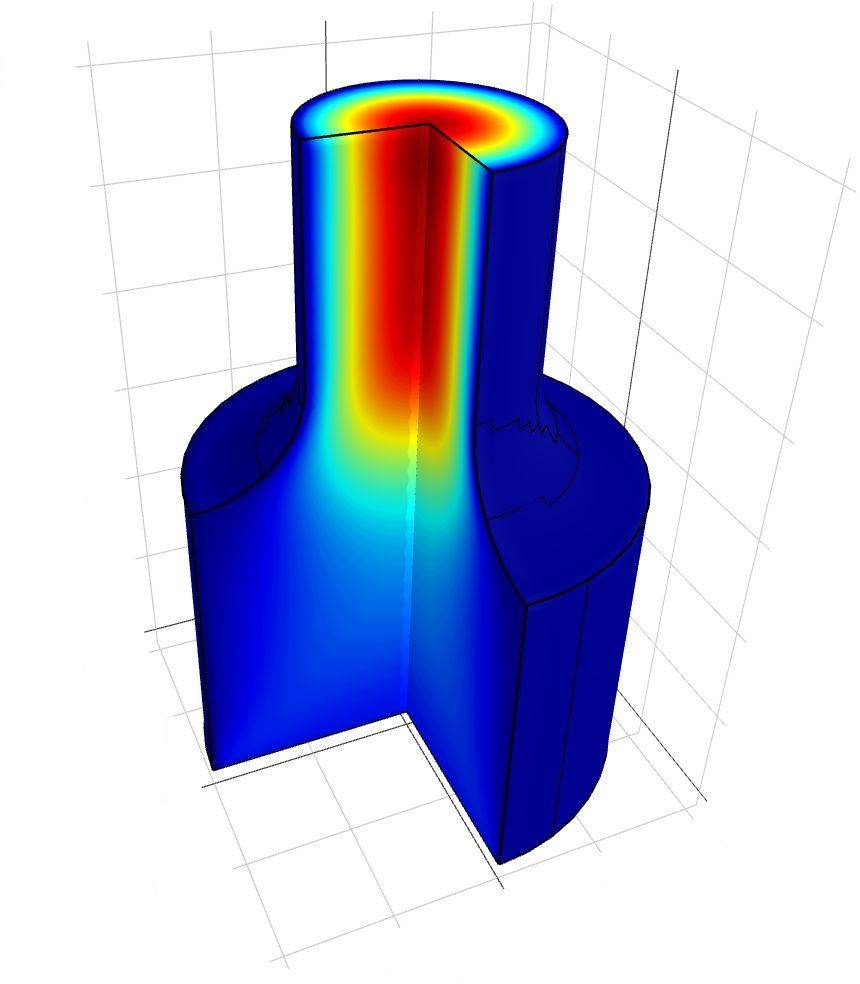FEATool is designed to be able to perform complex multiphysics simulations in arbitrary dimensions (1D, 2D, and 3D). However, running full 3D simulations often requires a significant amount of computational resources in the form of memory and simulation time. It is therefore desirable to find simplifications to reduce simulations to two or even one dimension if possible.
Problems which feature cylindrical and rotationally symmetric geometries and solutions can be reduced to two dimensions through a cylindrical or axisymmetric coordinate transformation (also referred to 2.5D). A symmetry axis, usually r=0, is taken as reference around which the coordinates and PDE operators (gradient and divergence) are transformed. In this way the governing equations will be reduced to 2D while representing a rotationally symmetric three dimensional problem.
This example models fluid flow in a narrowing pipe section. The constriction of the pipe will accelerate the flow according to the venturi effect. As the fluid is assumed to be both laminar and isothermal the problem is governed by the incompressible Navier-Stokes equations. For scalar equations like the convection and diffusion, and heat transfer equations axisymmetric transformation simply results in a multiplication of the equation with the radial coordinate. In this case the vector valued equations results in additional terms compared to the usual Cartesian case
$$ \left\{\begin{aligned} r\rho\frac{\partial u}{\partial t} - r\mu(2\frac{\partial^2 u}{\partial r^2} + \frac{\partial^2 u}{\partial z^2} + \frac{\partial^2 v}{\partial r\partial z}) + r\rho(u\frac{\partial u}{\partial r} + v\frac{\partial u}{\partial z}) - 2\mu\frac{\partial u}{\partial r} + 2\mu\frac{u}{r} + r\frac{\partial p}{\partial r} &= 0 \\\\ r\rho\frac{\partial v}{\partial t} - r\mu( \frac{\partial^2 v}{\partial r^2} + \frac{\partial^2 u}{\partial z\partial r} + 2\frac{\partial^2 v}{\partial z^2}) + r\rho(u\frac{\partial v}{\partial r} + v\frac{\partial v}{\partial z}) - \mu\frac{\partial u}{\partial z} -\mu\frac{\partial v}{\partial r} + r\frac{\partial p}{\partial z} &= 0 \\\\ u + r\frac{\partial u}{\partial r} + r\frac{\partial v}{\partial z} &= 0 \end{aligned}\right. $$
In addition to changing the equations, an appropriate boundary condition for the symmetry boundary must be chosen. A homogeneous Neumann insulation/symmetry condition is typically employed for scalar equations, but in the case of fluid flow a slip condition preventing any radial velocity while allowing flow in the axial direction is appropriate.
This model is available as an automated tutorial by selecting Model Examples and Tutorials… > Fluid Dynamics > Axisymmetric Fluid Flow from the File menu, and also as the MATLAB simulation m-script example ex_navierstokes8. Step-by-step tutorial and video instructions how to set up and run this model are linked below.
